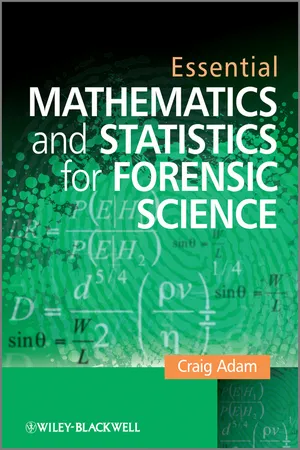
- English
- ePUB (mobile friendly)
- Available on iOS & Android
Essential Mathematics and Statistics for Forensic Science
About this book
From a basis of high school mathematics, the book develops essential quantitative analysis techniques within the context of a broad range of forensic applications. This clearly structured text focuses on developing core mathematical skills together with an understanding of the calculations associated with the analysis of experimental work, including an emphasis on the use of graphs and the evaluation of uncertainties. Through a broad study of probability and statistics, the reader is led ultimately to the use of Bayesian approaches to the evaluation of evidence within the court. In every section, forensic applications such as ballistics trajectories, post-mortem cooling, aspects of forensic pharmacokinetics, the matching of glass evidence, the formation of bloodstains and the interpretation of DNA profiles are discussed and examples of calculations are worked through. In every chapter there are numerous self-assessment problems to aid student learning.
Its broad scope and forensically focused coverage make this book an essential text for students embarking on any degree course in forensic science or forensic analysis, as well as an invaluable reference for post-graduate students and forensic professionals.
Key features:
- Offers a unique mix of mathematics and statistics topics, specifically tailored to a forensic science undergraduate degree.
- All topics illustrated with examples from the forensic science discipline.
- Written in an accessible, student-friendly way to engage interest and enhance learning and confidence.
- Assumes only a basic high-school level prior mathematical knowledge.
Frequently asked questions
- Essential is ideal for learners and professionals who enjoy exploring a wide range of subjects. Access the Essential Library with 800,000+ trusted titles and best-sellers across business, personal growth, and the humanities. Includes unlimited reading time and Standard Read Aloud voice.
- Complete: Perfect for advanced learners and researchers needing full, unrestricted access. Unlock 1.4M+ books across hundreds of subjects, including academic and specialized titles. The Complete Plan also includes advanced features like Premium Read Aloud and Research Assistant.
Please note we cannot support devices running on iOS 13 and Android 7 or earlier. Learn more about using the app.
Information



Table of contents
- Cover
- Title
- Copyright
- Preface
- 1: Getting the basics right
- 2: Functions, formulae and equations
- 3: The exponential and logarithmic functions and their applications
- 4: Trigonometric methods in forensic science
- 5: Graphs - their construction and interpretation
- 6: The statistical analysis of data
- 7: Probability in forensic science
- 8: Probability and infrequent events
- 9: Statistics in the evaluation of experimental data: comparison and confidence
- 10: Statistics in the evaluation of experimental data: computation and calibration
- 11: Statistics and the significance of evidence
- References
- Bibliography
- Answers to self-assessment exercises and problems
- Appendix I: The definitions of non-SI units and their relationship to the equivalent SI units
- Appendix II: Constructing graphs using Microsoft Excel
- Appendix III: Using Microsoft Excel for statistics calculations
- Appendix IV: Cumulative z-probability table for the standard normal distribution
- Appendix V: Student’s t-test: tables of critical values for the t-statistic
- Appendix VI: Chi squared χ2 test: table of critical values
- Appendix VII
- Index